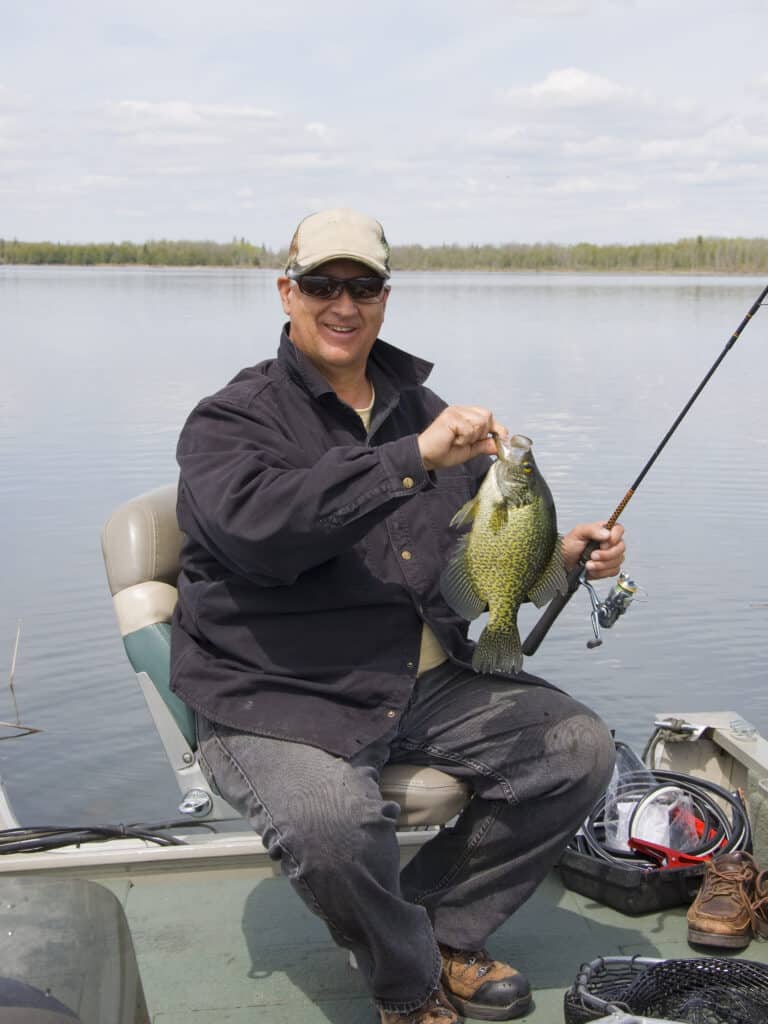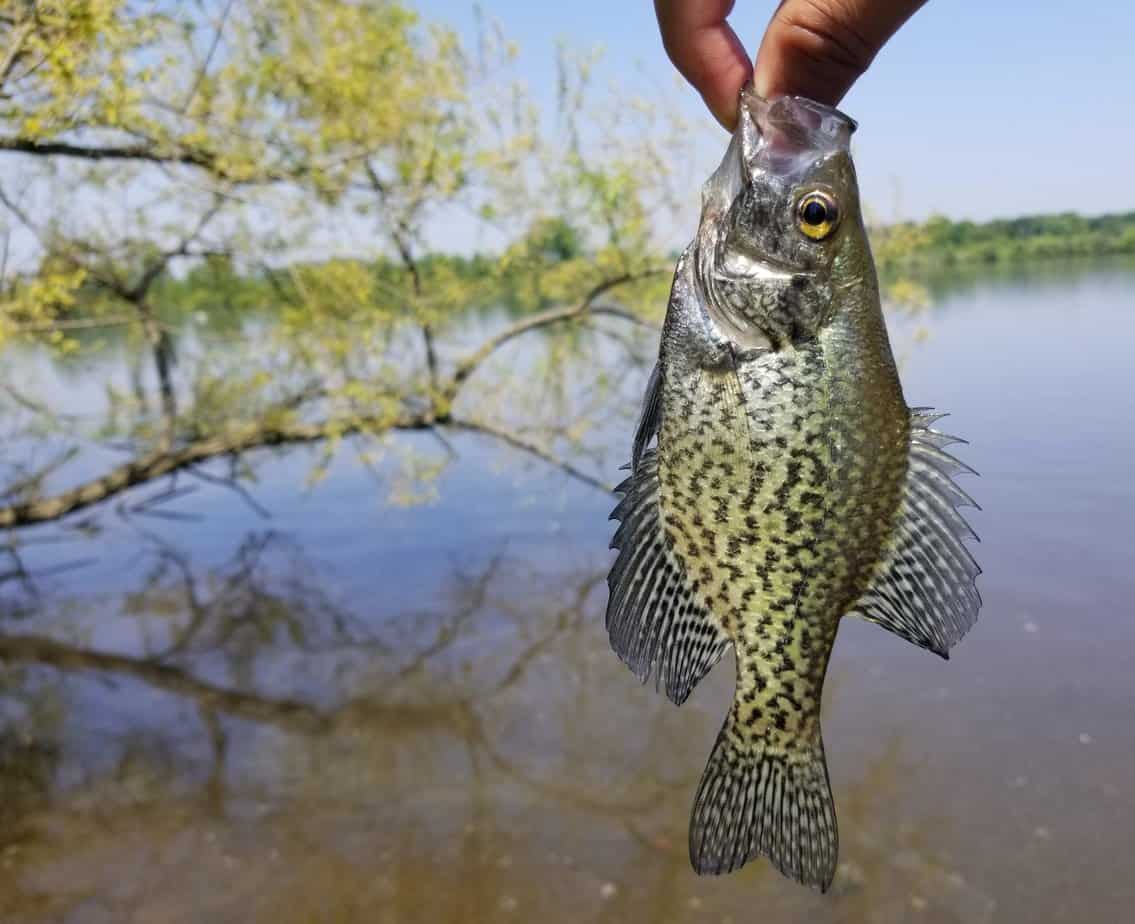Crappie fishing is a popular pastime for anglers of all skill levels, offering both a fun and rewarding experience.
As a beginner, it’s essential to understand the basics of fishing for crappie, including the difference between the two species: black crappie and white crappie.
While their appearance varies, these species share similar habitats and habits, making the fishing techniques practically interchangeable.
To get started with crappie fishing, beginners should gather the appropriate gear, such as smaller spinning rods and reels with light six-pound test line, and a bobber rig with a small bobber sufficient to support the rig and float.
The key to successfully catching crappie lies in targeting locations where minnows hide, such as brush, weeds, fallen trees, or even structures like docks and piers since crappie are mainly minnow eaters.
Crappie Basics
Types of Crappie
There are two main types of crappie species you should know about: the white crappie and the black crappie. While they may look similar, there are some key differences:
- White crappie: Lighter color, vertical bars, and 6 dorsal fin spines
- Black crappie: Darker color, irregular speckles, and 7 – 8 dorsal fin spines
Crappie Habitat
Crappie are a structure-oriented fish species, which means they are often found around submerged objects like fallen trees, logs, and reefs.
When fishing for crappie, it’s essential to pay attention to these specific habitats, as they will increase your chances of locating and catching crappie successfully.
In addition, crappie are known to prefer shallow, slow-moving waters with vegetation, typically around 5 to 15 feet deep.
They are most active during spring and fall, though they can still be caught in summer and winter with proper techniques.
To find crappie in open water, use your electronics to locate schools of fish. Crankbaits are often a useful tool for catching crappie suspended in open water, according to BassOnline.
Equipment Essentials
Rods and Reels
When crappie fishing, a good quality rod and reel are essential.
Beginners should consider using smaller spinning rods and reels, designed specifically for the type of fishing they’ll be doing.
Ultralight spinning or spin-casting reels equipped with 4- or 6-pound test line and 5- to 5-1/2-foot-long rods are commonly preferred among anglers.
Additionally, fly rods, telescoping fiberglass rods, and cane poles are also popular choices.
Line Selection
When it comes to line selection, using light line is crucial for crappie fishing.
Lighter lines in the 4- to 6-pound-test range are typically recommended as they work well for casting jigs weighing from 1/64- to 1/16-ounce.
The lighter line will allow you to feel the subtle bites from crappie, which can be easily overlooked with heavier lines.
Crappie Baits and Lures
There are a variety of artificial fishing lures that can be effective when fishing for crappie.
These include crankbaits, soft-bodied plastic baits, plugs, spinner baits, and flies.
However, beginners may find it easier to start with live bait or jigs, as these tend to be more effective for catching crappie.
Jigs are particularly versatile and can be deadly lures for catching crappie.
When selecting jigs, aim for weights between 1/64- and 1/16-ounce, as these lighter jigs often outperform heavier ones.
Additionally, pairing smaller jigs with a bobber rig that has small bobbers can help improve your chances of success.
The bobbers should be just large enough to support the rig and still float.
Fishing Techniques

Crappie fishing is an enjoyable and straightforward activity for beginners.
In this section, we will discuss three basic fishing techniques: casting, vertical jigging, and trolling.
Casting
Casting is a popular method for crappie fishing. It involves using lightweight rods and reels to cast small lures or live bait into areas where crappie are likely to be found.
Focus on fishing around structures like fallen trees, bushes, old piers, and flooded weeds that attract minnows, the primary food source for crappie.
Cast your bait and let it sink to the desired depth.
You can use small tube jigs (usually two-inchers, rigged on 1/8th to 1/64th of an ounce jig heads), with colors like red/white, chartreuse, or pink being commonly effective.
Retrieve slowly and experiment with different depths to find the most active crappie.
Vertical Jigging
Vertical jigging involves lowering your lure or bait vertically into the water column to a depth where crappies may be present.
You can either use your boat’s depth finder to locate schools of crappie or rely on your intuition and experience.
Once you find a promising spot, lower your jig or live bait down to the desired depth, and move it gently up and down.
Keep an eye on your line for subtle movements that could indicate a crappie bite. One trick to use is a slip knot, which allows the lure to move more freely on the line.
Trolling
Trolling is another technique used for crappie fishing. It involves moving your boat slowly with your bait or lure trailing behind.
Crappie often congregate near submerged structures like brush piles, logs, or underwater vegetation.
Tie a small lure or hook with live bait to and set it at the desired depth, then troll the area at a slow and steady speed.
Monofilament line is often recommended due to its low visibility.
Be patient and pay close attention to your line and rod tip while trolling.
When you feel a bite, set the hook and reel in your catch. Experiment with different trolling speeds and depths to find the most productive approach.
Finding Crappie Hotspots
Finding crappie hotspots is an essential skill for beginners. It can make a significant difference in your success while fishing these tasty, fun-to-catch fish.
Let’s explore some tips to help you locate these prime fishing spots.
First, consider the depth. Crappie are likely to be found in different water depths depending on the time of year and the temperature.
In the spring, they usually inhabit shallow water, making it easy to find them close to shore. As the water temperature rises, they move to deeper waters to find cooler temperatures.
In the fall, they start to return to shallower depths in search of food.
According to Crappie Angler Guide, start with a certain depth and then adjust your approach, moving up or down the water column until you find the depth where crappie are actively feeding.
Another important factor in finding crappie hotspots is structure.
Crappie are known to congregate around underwater structures, such as submerged trees, weed beds, or man-made structures like docks and fishing piers.
When trying out a new lake, Fishing Duo suggests looking for these structures and focusing your efforts there.
Using electronics, such as side imaging sonar or fish finders, can also be a game changer when searching for crappie hotspots.
As explained by Angling Buzz, side imaging technology helps you spot schools of crappie that might be hiding near structures or in deeper waters.
In summary, finding crappie hotspots requires a mix of understanding the fish’s behavior, targeting structures, adjusting depths accordingly, and potentially utilizing electronic tools to spot their location. With practice and patience, you’ll be catching crappie in no time.
Seasonal Strategies
Spring
During the spring, crappies move into shallow waters to spawn. They can be found near any brush or weeds, as these are areas where minnows hide, which are part of the crappie’s diet.
Spring is an excellent time to fish for crappie using small jigs or lures that imitate minnows and insects.
Summer
In the summer, crappies seek deeper waters ranging from 15 to 25 feet to find cooler temperatures and food sources.
You can locate them around creek channels, underwater ledges, and secondary points. It’s essential to have an understanding of where to find baitfish and structure, as crappies usually are close by.
Fall
As the water temperature drops during the fall, crappies may move back to shallow waters.
This presents another opportunity to target them using fish-imitating lures or a combination of fish-insect lures, depending on the water and weather conditions.
Spinnerbaits are also effective during this time.
Winter
Winter crappies tend to be found in deeper waters, making it crucial to understand the depth, structure, and location of baitfish in your fishing area.
Anglers can use ice fishing techniques, small jigs, or live bait to attract crappies during this season, as these adaptations allow for slow presentations that entice inactive fish.
Crappie Fishing Etiquette
When embarking on your crappie fishing journey, it is essential to follow proper etiquette to ensure a pleasant experience for yourself and others around you.
In this section, we will discuss a few key points that beginners should keep in mind while fishing for crappie.
First, always respect other anglers by giving them ample space to fish.
Whether fishing from a boat or the shore, maintain a reasonable distance from others to avoid crowding and ensure that everyone can enjoy the moment.
This also includes being mindful of casting lines in the vicinity of others or near their fishing spots.
Additionally, practicing catch and release is highly encouraged, especially when catching crappie that are smaller or below the legal size limit.
However, it’s hard to beat fresh, fried crappie…my personal favorite.
This preserves the fish population and supports sustainability within the ecosystem.
To make it easier for the fish to recover, handle them gently and use a barbless hook or pinching down any barbs on the hook to facilitate a quick release.
While enjoying your time on the water, remember to follow all local rules and regulations.
This may include acquiring the appropriate fishing license, adhering to catch limits, and being aware of any seasonal restrictions.
Lastly, clean up after yourself by disposing of trash, leftover bait, and fishing accessories in designated areas or taking them back with you.
Not only does this protect the environment, but it also ensures that the fishing spot remains pristine for future visitors to enjoy.
Conclusion
In summary, crappie fishing is an enjoyable and rewarding activity for beginners, with the potential for great catches and a tasty meal.
As a novice angler, it’s essential to keep in mind the basic crappie fishing techniques and gear required for a successful day on the water.
Remember to consider the seasons when planning your crappie fishing trips, as fish behavior and location can vary.
Winter fishing can be particularly productive if you know where to look for crappie.
Don’t forget to experiment with various bait and lure options to find what works best in your chosen fishing spot.
Lastly, always be patient and persistent as a beginner.
Crappie often stays close to structure, so getting snagged may be frustrating but ultimately worth it as you hone your skills.
Enjoy the process of discovering new spots, methods, and techniques, and share your successes with fellow anglers.
Good luck on your crappie fishing journey!

